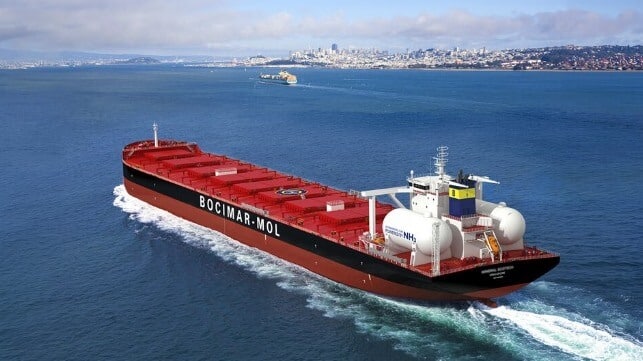Mitsui O.S.K. Lines Launches Ammonia Bunkering in Australia

Japan’s Mitsui O.S.K. Lines (MOL) is set to spearhead a groundbreaking ammonia bunkering operation in Australia’s Pilbara region, aiming to establish a green shipping corridor between the iron ore-rich area and Asia. This initiative marks MOL as the first shipping company to join the project, which was unveiled in June, and focuses on bunkering Capesize bulkers that transport iron ore while also developing an ammonia export business.
Partnerships and Project Goals
MOL is collaborating with NH3 Clean Energy, an Australian firm tasked with supplying blue ammonia, and Oceania Marine Energy, which will manage the bunkering operations. The Pilbara Ports Authority is also involved, overseeing the management of the Port of Dampier, where the bunkering operations are expected to take place. They will be responsible for issuing the necessary bunkering licenses.
The project aims to initiate bunkering operations for Capesize bulkers at the ports of Dampier and Port Hedland by 2030. The Pilbara region, recognized as the world’s largest iron ore export port, is deemed an ideal location for this initiative. The project is designed to support the maritime industry’s transition to cleaner fuels, aligning with global decarbonization efforts.
MOL has already made strides in this direction by committing to ammonia dual-fuel vessels in partnership with CMB.TECH. The company plans to charter and operate three Capesize bulkers currently under construction by China State Shipbuilding Corp.’s Qingdao Beihai Shipbuilding Company. This partnership, initiated in 2023, involves the development of a 72-bore ammonia-fueled engine in collaboration with WinGD. MOL has agreed to a 12-year charter for each of the three vessels, bringing valuable operational insights to the ammonia bunkering project.
Future Prospects and Industry Impact
Sam McSkimming, CEO of Pilbara Ports, emphasized the significance of the project, stating, “With approximately 4,000 vessel visits associated with bulk exports and more than 1,000 distinct bulk carriers visiting our ports annually, the Pilbara is a natural beachhead to kick-start the clean fuel transition.” He highlighted that the region possesses the scale, stable demand, and port infrastructure necessary to support substantial investments in maritime decarbonization.
NH3 Clean Energy is also advancing its WAH2 project in nearby Maitland, which will utilize existing gas and pipeline infrastructure alongside carbon capture technology to produce clean ammonia. The company anticipates an initial bunkering demand of 300,000 tons per annum (TPA) of clean ammonia, representing about half of the planned production capacity from Phase 1 of the WAH2 project. The remaining capacity will be available for export to heavy industries, including power generation. NH3 Clean Energy is currently conducting pre-FEED studies and expects that the new agreement with MOL will aid in reaching a final investment decision by the end of 2026.
